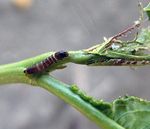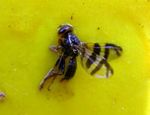Aphids, Peach Twig Borer, Western Cherry Fruit Fly - IPM Pest ...
←
→
Page content transcription
If your browser does not render page correctly, please read the page content below
Aphids, Peach Twig Borer, Western Cherry
Fruit Fly
In this Issue
Fruit aphids: rosy apple aphid, green peach aphid, woolly apple aphid
Apple, Pear: codling moth updated spray dates table; fire blight
Peach/Nectarine, Apricot, Plum: peach twig borer spray dates
Cherry: western cherry fruit fly treatment starts when fruits turn salmon blush color
APHIDS
Rosy Apple Aphid and Green Peach Aphid
Green peach aphids cause peach leaves to become tightly curled. As the aphids grow, they shed
their skins, leaving behind hundreds of white exoskeletons.Small colony of rosy apple aphids on the underside of an apple leaf. Rosy apple aphids cause leaf-curling as they feed, and can distort the fruit. Aphids thrive in cooler temperatures and their eggs easily survived our mild winter of 2021. As a result, their populations are high this season. They are almost at their peak now on apples, peaches, and other fruit trees. On apples, we are primarily seeing rosy apple aphid and on peach and plum, it is green peach aphid. Both species cause tightly curled leaves, and also cause leaves to turn yellow and drop. Of the two, rosy apple aphid is more of a concern for commercial growers because their feeding near fruit causes the fruit to become flattened and distorted. The good news is that both aphid species will migrate away from fruit trees in a few weeks to spend the summer on weeds, vegetables, and other host plants. In addition, a new flush of growth will “hide” the damaged foliage. If the damage is not bad, ignore the aphids and let natural enemies such as lady beetles and lacewings have their meals.
Treatment
Residential: insecticidal soap (organic; many brands), horticultural oil (organic; 1%), pyrethrin
(organic; many brands), Spectracide Triazicide, GardenTech Sevin
Commercial: Admire Pro (or generic), Beleaf, Assail
Woolly Apple Aphid
An infestation of woolly apple aphids can
coat twigs and small branches.
When monitoring for woolly apple aphid,
first check the edges of old pruning cut
Woolly apple aphids were spotted in Davis and Utah counties this week, and the coming warm
weather will provide conditions for increased population growth.
Look for these aphids in old pruning cuts, tree wounds, or cracks and crevices in the bark. They also
feed on roots, and some aphids stay on roots year-round, while others migrate up the bark in spring
and summer, and then migrate back in fall.
This aphid is much more difficult to manage that the aphids discussed above, in that they produce a
waxy, cottony secretion that protects their bodies from pesticides and predators. They are also
different in that they feed on twigs, bark and roots, rather than foliage alone.
We are finding that this aphid is becoming more and more common in backyard trees due to our
milder winters. So it is very important to scout your own trees to determine when and if a treatment
is needed. Again, look for them around old pruning scars or wounds, and on root suckers.Treatment
If woollies are a problem every year, it is best to treat them early! Otherwise, treat them when they
are covering more than 10% of the tree.
Because of the aphid’s thick, waxy coating, it is important to spray the trees to dripping to reach and
penetrate the aphid colonies.
Residential growers can use insecticidal soap mixed with 1% horticultural oil, aimed directly at
the colonies, or Spectracide Triazicide mixed with 1% oil.
Options for commercial growers: click here.
APPLE, PEAR
Codling Moth
Codling moth dates of “greatest egg hatch” are coming up for northern Utah locations.
View a pdf of the updated spray timing table. Be sure to read the instructions at the top of the page,
for how to read the table.
Soon, codling moths in most northern Utah locations will be in the “period of greatest egg hatch.”
What this means is that 75% of all eggs for the first generation will be hatching over a 2 to 3 week
period. So if you applied a treatment for the start of egg hatch, be sure to re-apply once or twice
during the date range shown on the table.
If you have not sprayed or want to spray minimally, keep fruit protected during this period of rapid
egg hatch.
Treatment
See the May 14, 2021 post for a table of products (under Codling Moth)
Options for commercial growers.
Fire Blight
Fire blight infections occur through the
blossoms and turn tissue brown or black.In northern Utah, we are now seeing damage from fire blight (infections happened during bloom) in orchards. Be sure to inspect flower clusters on your trees for wilting and brown/black tissue. If infected fruit clusters are found, prune out the tissue right away. At this time of year, prune out twice the length of the symptomatic twig or shoot. Infections that are not pruned out will continue to expand within the plant tissue, killing a greater portion of the branch. In this case, the branch will need to be pruned out up to 12 inches beyond the infected area. So it is best to prune now! PEACH/NECTARINE, APRICOT Peach Twig Borer Treatment dates for early June in northern Utah locations In spring, peach twig borer larvae seek out succulent shoots. Later in the summer, they feed within fruits. View a pdf of the spray timing table. Peach twig borer affects peaches, nectarines, and apricots. Unlike codling moth on apples, this pest is more sporadic in Utah, and some locations have a low enough population that does not need to be treated. The treatment table shows when to start treating the first generation for additional northern Utah locations. In general, just a single application is sufficient for the first generation. This spray will lower the population, and prevent shoots from being attacked. But during the second generation (which can attack the fruit), you may need to apply insecticide regularly so that your tree is protected throughout the egg-hatch period. Treatment
Residential: Use the same options provided for Codling Moth, found in the table of the May
14, 2021 post.
Commercial: Treatment options are found in the Intermountain Tree Fruit Guide.
CHERRY
Western Cherry Fruit Fly
Western cherry fruit fly captured on a
yellow sticky trap. It has a distinctive wing
pattern.
We captured western cherry fruit flies on the USU Research Farm in Kaysville, UT this week. The
traps are in an orchard with a very high population, so it is the earliest site that we see them active
in northern Utah.
The time to treat for the “worms in the cherry” is based on the development of your own tree. Watch
the fruit color. It will go from green to yellow, and then quickly develop a rosy blush. Once that rosy
blush forms, then the female flies are able to penetrate the fruit skin and lay eggs inside.
Therefore, treatment should begin as soon as cherries develop the salmon blush color. Base this off
the fruits in the sunniest location of the tree, which is often toward the top or on the south side.
Treatment Options – ResidentialWestern cherry fruit fly cannot lay eggs
within fruit until they become soft enough,
which is when a salmon-blush color
appears.
Conventional:
Malathion (malathion): every 7 days
Bonide Fruit Tree Spray (carbaryl): every 14 days
GardenTech Sevin or Spectracide Triazicide (pyrethroids): every 14 days
Organic:
Fertilome / Gardens Alive / Bull’s Eye / Monterey (spinosad): every 7 days
Safer BioNEEM (azadirachtin): every 7 to 10 days
Treatment – Commercial Growers
Commercial growers, click here.You can also read


























































